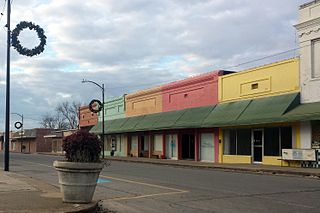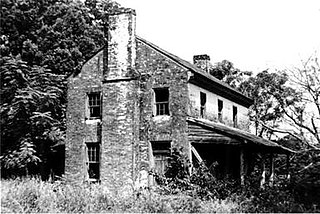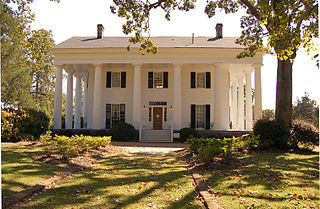Related Research Articles

Lake Village is a city in and the county seat of Chicot County, Arkansas, United States. The population was 2,575 at the 2010 census. It is located in the Arkansas Delta. Lake Village is named for its location on Lake Chicot, an oxbow lake formed by the Mississippi River.

Ward Hall is a Greek Revival antebellum plantation mansion located in Georgetown, Kentucky. The main house covers 12,000 square feet (1,100 m2), with 27-foot (8.2 m) high Corinthian fluted columns.

Waverley is a mansion, formerly a plantation house and now a historic house museum, in Clay County, Mississippi, ten miles east of West Point. Built in the 1838, it is architecturally unique among Mississippi's antebellum mansions for its enormous octagonal cupola. It was declared a National Historic Landmark in 1973.

The McGehee–Stringfellow House, also known as Oak Grove, was a historic plantation house near Greensboro, Alabama, United States. It was added to the National Register of Historic Places on September 17, 1980, due to its architectural significance. It was accidentally destroyed in the 1980s during an attempt to move it to another location.

Antebellum architecture is the neoclassical architectural style characteristic of the 19th-century Southern United States, especially the Deep South, from after the birth of the United States with the American Revolution, to the start of the American Civil War. Antebellum architecture is especially characterized by Georgian, Neo-classical, and Greek Revival style homes and mansions. These plantation houses were built in the southern American states during roughly the thirty years before the American Civil War; approximately between the 1830s to 1860s.
McGehee House may refer to:

Annandale Plantation was a cotton plantation worked by enslaved laborers in what is now the Mannsdale neighborhood of Madison, Mississippi.
The Wyolah Plantation is a historic Southern plantation in Church Hill, Jefferson County, Mississippi. It is located off the Mississippi Highway 553.

Edward McGehee was an American judge and major planter in Wilkinson County, Mississippi. He owned nearly 1,000 slaves to work his thousands of acres of cotton land at his Bowling Green Plantation.
John Ker (1789–1850) was an American surgeon, planter, and politician in Louisiana. Together with several major Mississippi planters, in the 1830s Ker co-founded the Mississippi Colonization Society (MCS), promoting the removal of free people of color to a colony in West Africa. The MCS modeled itself after the American Colonization Society, the national organization for which Ker later served as a vice president.

Gloucester is a historic mansion in Natchez, Mississippi. It is located on Lower Woodville Road in South Natchez. It was designed by local architect Levi Weeks and was listed on the National Register of Historic Places in 1976.

Lansdowne is a historic mansion that is listed on the National Register of Historic Places in Natchez, Adams County, Mississippi. It was originally built as the owner's residence on the 727-acre, antebellum, Lansdowne Plantation. The mansion and 120 acres are still owned and occupied by the descendants of the builder, who open it periodically for tours.

Glenfield Plantation is a one-level historic antebellum home in Natchez, Mississippi. Glenfield was built in two distinct architectural periods on a British land grant originally deeded to Henry LeFluer by King George III. The original 500 acres grew to a 2000-acre working cotton plantation through various ownerships, circa 1774-1812 and 1845–1850. Glenfield was listed on the National Register of Historic Places in Mississippi in 1990.

Golladay Hall is a historic mansion in Grenada, Mississippi, USA. It was built in the 1850s on a Southern plantation for the Golladay family, members of the Southern aristocracy from Tennessee who owned plantations and invested in railroads. The mansion was used by Jefferson Davis, the President of the Confederate States of America, during the American Civil War. In 1932, a Golladay heiress was murdered inside the house. The mansion was restored in the 1950s.
The Cliffs Plantation is a Southern plantation with a historic mansion located in Natchez, Mississippi, USA.
The Desert Plantation is a Southern plantation with a historic house located in Pinckneyville, Mississippi in the Tunica Hills.
Holly Grove is a Southern plantation with a historic house located in Centreville, Mississippi, USA.
Isom Place is located at 1003 Jefferson Avenue in Oxford, Mississippi and listed on the National Register of Historic Places. The home was constructed by Thomas Dudley Isom, a physician in Lafayette County. The exact dates of construction are lost, due in part to a lack of records from 1865 to 1883. The earliest version of the structure was a two or three bedroom cabin, but by 1840 Isom used the cabin as a core for the current home.

The McGehee House is a historic mansion in Hammond, Louisiana, U.S..
The Laurel Hill Plantation in Jefferson County, Mississippi near Rodney, Mississippi was a historic plantation. It is located about two miles southeast of Rodney, in a bend of the Mississippi River named "Petit Gulf". It is significant for the architecture of its main plantation house and for the development of Petit Gulf cotton, a cotton hybrid, on its property.
References
- 1 2 "McGehee Plantation". National Park Service. Retrieved September 3, 2015.
- 1 2 3 4 5 6 7 "National Register of Historic Places Nomination Form: McGehee Plantation" (PDF). Mississippi Department of Archives and History . Retrieved September 3, 2015.